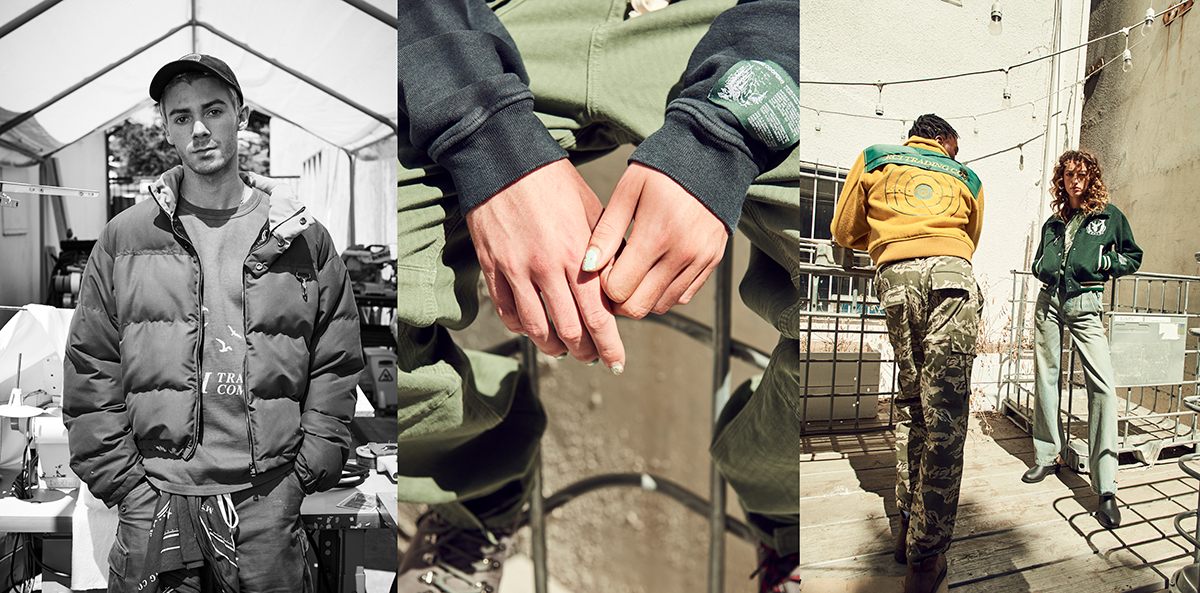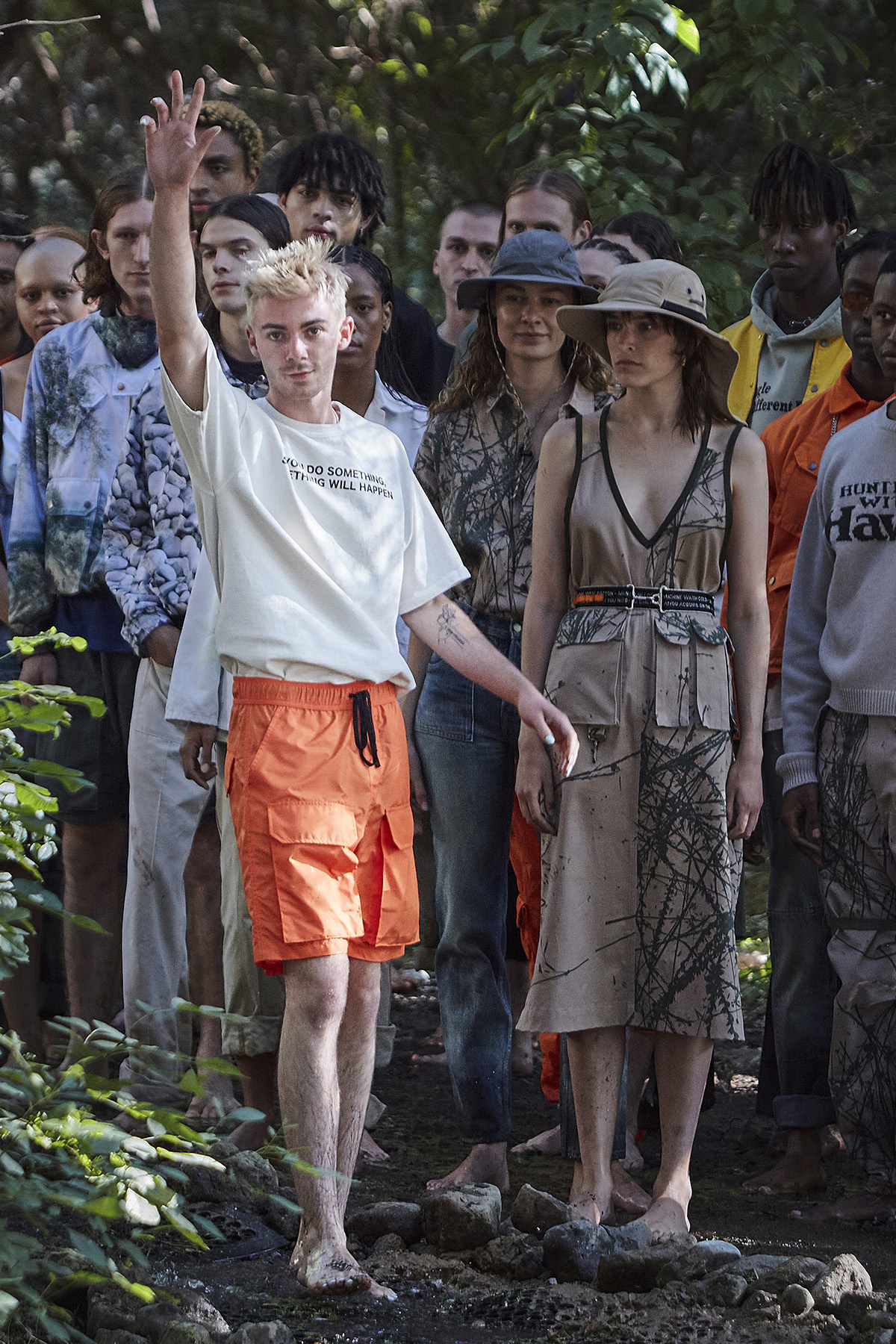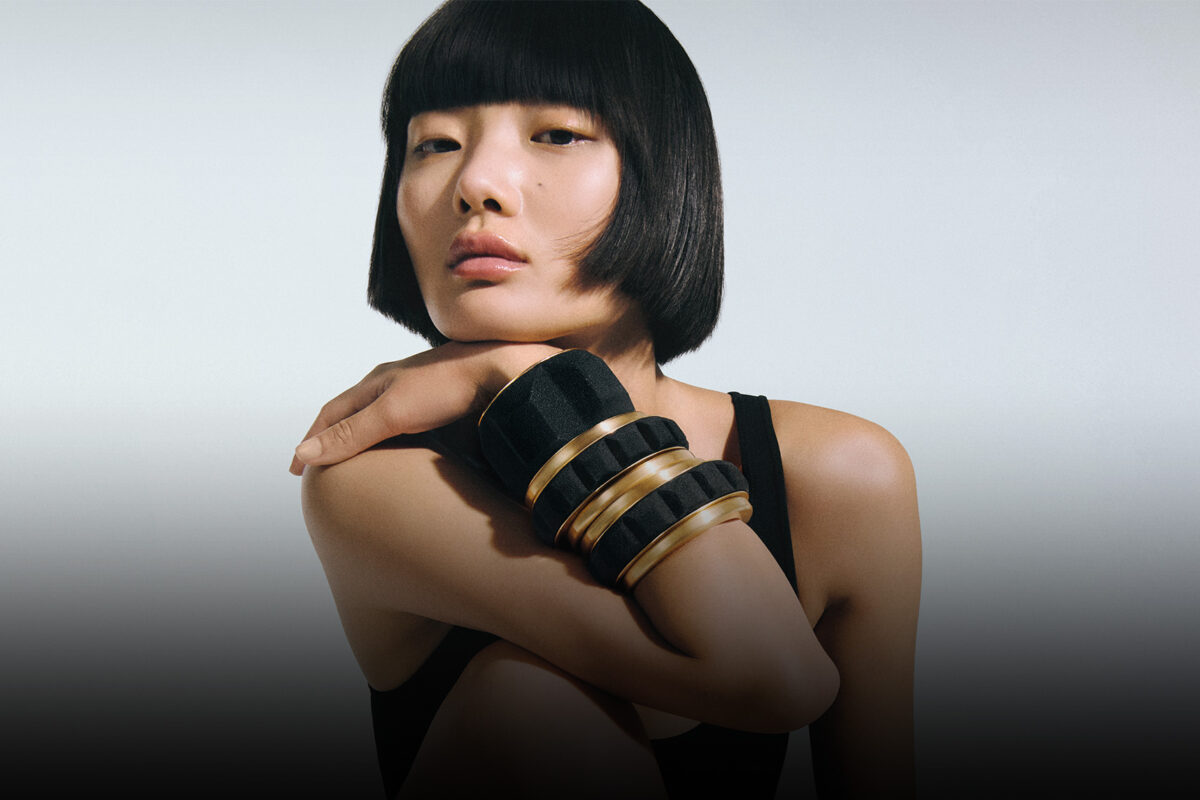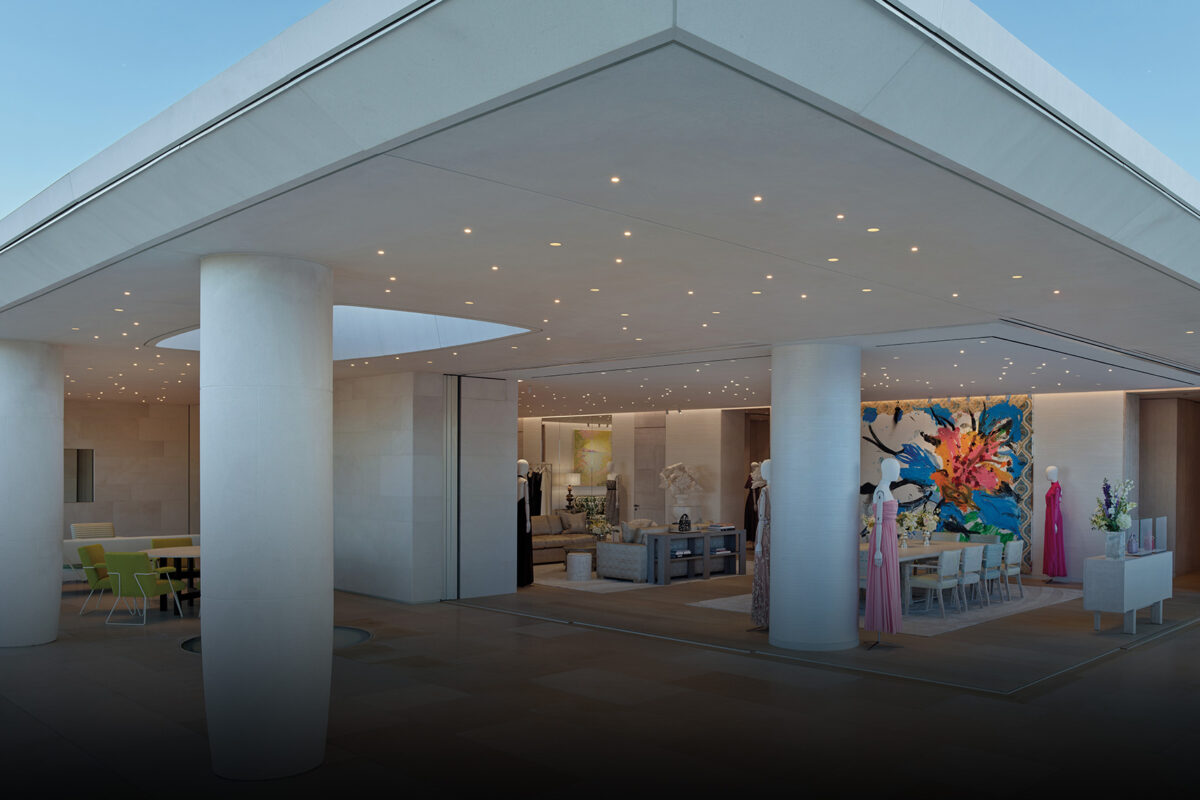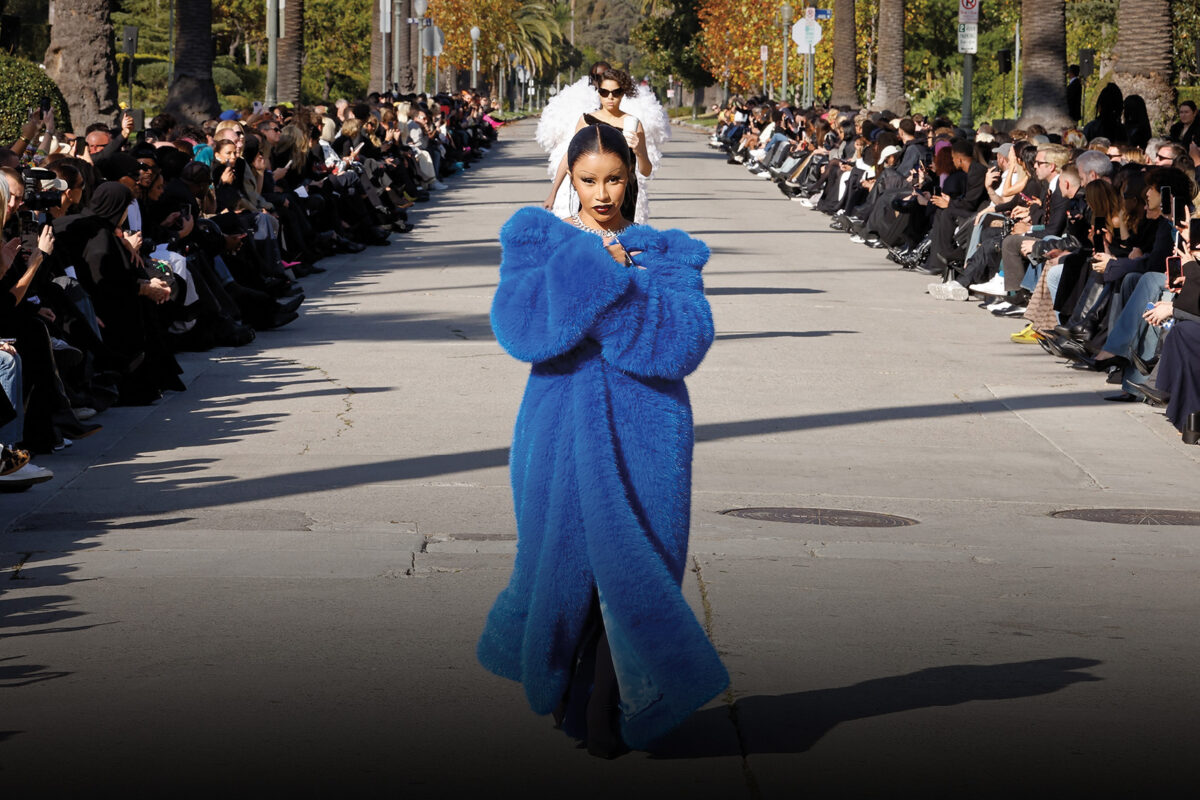The 22-year-old designer’s hyper-relevant collections blend historic workwear with California’s abundant nature, capturing the survivalist spirit of our times
Words by STEPHANIE RAFANELLI
Photography by LEE MORGAN
Creative & Fashion Direction by ALISON EDMOND
One morning, a few weeks into L.A.’s shutdown, Reese Cooper woke up with a very specific impulse. “I need to swim in fresh water today,” he declared to his roommate, Charlie. “How do we make that happen?” This is a common follow-up question of the 22-year-old designer — the youngest to ever receive a CFDA/Vogue Fashion Fund nomination (in 2019) — whose bleach-blond hair is sprayed aloft, as if held up with the static electricity of a sudden idea. The pair set out on an off-the-cuff road trip driving out an hour north of the city. “We found this magical creek. There were no people around.” And, as is Cooper’s way, he dived in.
Model Emilia wears the REESE COOPER jacket, $885, shirt, $185, and pants, $625, while model Floyd sports the shirt, $500, and pants, $480, with SEASON THREE boots, $345.
From that mental spark-turned-moment came the Spring/Summer 2021 collection of his reinvented workwear, entitled River Runs Through, and its pro-active tagline — “If you do something, something will happen” — a credo to manifesting. Unable to show on a watery set in a Parisian school as planned in June, Reese improvised, turning a stream in Thousand Oaks into a runway for Fashion Week Online; male and female models waded barefoot along the currents in fishing vests, scout-ish patches, skirts and jackets painted with bucolic scenes and camouflage created by scanning Californian wildflowers collected on hikes. His friends, seated on the bank, constituted the disheveled front row; and Compton-born rapper Vince Staples of Cutthroat Boyz provided free-styled, spoken-word narration to the video presentation, referencing our wavering relationships to nature and positive action. The whole thing couldn’t have been more on brand.
“The best ideas are the impulse ones. You have to execute them while they are still fun in your brain”
REESE COOPER
Designer REESE COOPER wears the shirt, $185, bandanna, $48, and vintage pants.
Since Cooper moved at 18 to L.A. from London to found his eponymous label, he has experimented with, elevated and rewilded urban workwear, releasing it back into its natural habitat of the great American outdoors. Nominated this year for the CFDA’s American Emerging Designer of the Year Award (alongside Californians Kenneth Nicholson and the duo behind Staud), Cooper’s utilitarian designs seem to define the survivalist spirit of our times. Simultaneously, they reach out to a golden age of rural America that perhaps never truly existed, creating more of a psychic landscape. His modern heritage menswear and, now, womenswear collections (he doesn’t like the term “streetwear”) under the titles Lone Pine, Hitchhiking, Big Sky, Wind Chill and If A Tree Falls recall the communion of the lone human spirit with the elemental wilderness.
Looks from the Spring/Summer 2021 collection.
But Cooper’s vision is personal — an ongoing story of himself in a mythological wild America that, as a boy, he left behind when his mother, Leah, a lawyer, moved the family from Atlanta to London’s overwhelming metropolis. “My grandparents lived on a lake in the middle of Georgia,” he explains. “Then I lived in a very rural part of Colorado for nine months before moving [to London] when I was 11.” At 14, already captivated by the structure of things, Cooper was drawn to menswear on Tumblr, discovering BAPE (with whom he interned at 15), and the kind of streetwear whose genesis can be traced back to vintage Americana. “Once I was 17 or 18, I was curious to know what life would have been like if I hadn’t gone to live in the inner city,” he says. “So my work is completely an exploration of a parallel self.”
With this in mind, he eschewed fashion school for a nondidactic DIY approach (he dropped out after six weeks), absorbing everything he learned in double-quick time from two embryonic collections — one a hoodie collaboration with Flint Child Health and Development Fund. When he moved to California to harness L.A.’s historic workwear manufacturing, setting up his label in the aforementioned Charlie Giannettis’ Glassell Park textile factory, it was as if Cooper had been born at 18 as a full-fledged designer. He had the long-lensed vision of a film director, delivering his seasons as chapters of an ongoing narrative (“It’s damn near like styling a scene that doesn’t exist,” he says) in addition to a 24/7 work ethic similar to that of his friend Virgil Abloh, and the confidence to follow his instincts on the spin of a dime that only experience or youthful gumption brings.
REESE COOPER wears the puffer jacket, $1,950, shirt, $185, bandanna, $48, and vintage pants. Floyd wears the REESE COOPER varsity jacket, $1,495, shirt, $185, pants, $360, and belt, $50, with SEASON THREE boots, $345. Emilia dons the varsity jacket, $1,020, shirt, $185, and jeans, $595.
“The best ideas are always the impulse ones, and you have to be able to execute them while it’s still fun in your brain, otherwise you’re going to lose that momentum,” Cooper says. “I just grew up with my mum believing that this could work if I just went out and faced the whole sink-or-swim moment.” Creatively directing and managing the label solo, with Leah dealing legal emails from London, he was signed up by Barneys New York, Mr Porter and London’s Selfridges. More recently, for Harrods, he designed the Greyhound capsule collection, featuring jackets emblazoned with camouflage and hunting dogs.
“There’s the illusion that I’m a much bigger company, which was something I worked toward, so that stores would take my brand more seriously, rather than just ‘this kid making stuff,’” Cooper says. “I got an email two days ago with a resume from someone applying for ‘a job in the finance department of the Paris office.’ I don’t even have a finance department, let alone a Paris office!” He’s only taken on an assistant in the last three months.
REESE COOPER shirt, $185, worn with vintage pants.
But Cooper hopes to never be taken too seriously. His experimental approach to the construction of practical clothes in humble, workaday fabrics is at odds with the carved ivory towers of fashion. “Fashion week has been like a summer camp to me. Just all your global friends in the same place,” he says. “But I don’t like how seriously everyone takes it, because at the end of the day, all we do is make clothes for wealthier people. Nothing is that deep. … I resonate most with people like Heron [Preston] and Virgil. I’d rather hang out with people that have the same energy, rather than gatekeepers.”
Cooper’s version of fashion is, by contrast, democratic and inclusive. During lockdown, he debuted RCI-DIY, selling DIY pattern kits for chore jackets and ready-to-dye T-shirts to benefit youth charities. “I thought: I’m just going to make a playbook for people and hope they freestyle it from there,” he says. Sustainability was part of his production process from the get-go, using techniques like garment-dying to reduce fabric waste. “I never look at these things as an afterthought. No one has to convince me of this shit. … It’s a question of right or wrong.”
The pandemic, according to Cooper, has brought about a needed reality check for the fashion industry. Meanwhile, unable to travel as before, he’s created a more permanent home in L.A; he’s moving into a new apartment and office in downtown to nest as the Giannetti factory is relocating nearby. After clearing out, he donated around 200 T-shirts; he doesn’t buy them anymore, he’s only tempted these days by vintage options from L.A. dealer Moth Food.
REESE COOPER on the makeshift runway of his Thousand Oaks show.
He’s also getting a car, though in the absence of an electric Ford Bronco, he’s uncharacteristically torn about what he wants. “I also want a practical pickup truck,” he says. “But I also don’t want to be the guy that has a pickup truck that people call.” He’s leaving that decision — and others related to his future — to his instincts. “I’m not like: ‘One day I want to design for this or that house.’ That doesn’t really excite me,” he explains. His goals are much less starry, more aptly pragmatic and utilitarian: “What I want next is a full-time production manager, and I need a bookkeeper, that’s where my head’s at right now.” He chuckles again. “I’m so sick of scanning receipts.” Right now, in this age of reality checks, we can all relate to that.
Model EMILIA SCHMIER at Vision Los Angeles
Model FLOYD ZION at Q Management
Hair and Makeup by DEE DALY at Opus Beauty using Oribe and Glossier
Feature image: Floyd wears the REESE COOPER varsity jacket, $1,495, shirt, $185, pants, $360, and belt, $50, with SEASON THREE boots, $345; the designer wears the bandanna, $48, sweatshirt, $375, and pants, $540, with SEASON THREE boots, $345, and a vintage cap; Emilia dons the varsity jacket, $1,020, shirt, $185, and jeans, $595.
This story originally appeared in the September 2020 issue of C Magazine.
Discover more STYLE news.





